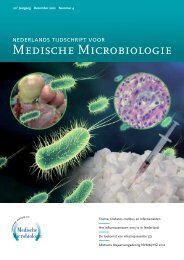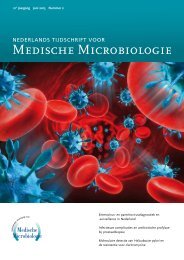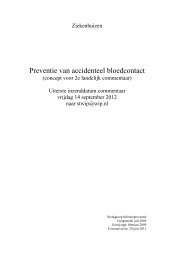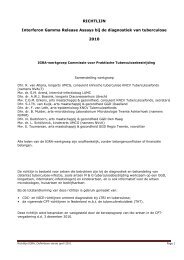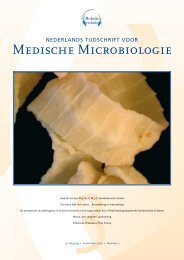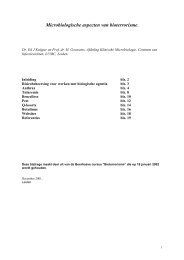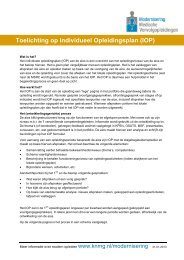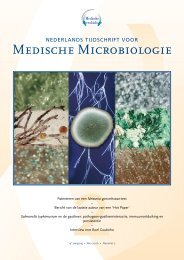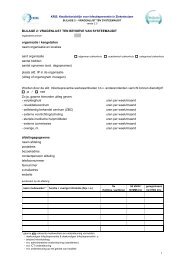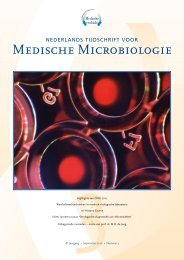Supplement bij veertiende jaargang, april 2006 - NVMM
Supplement bij veertiende jaargang, april 2006 - NVMM
Supplement bij veertiende jaargang, april 2006 - NVMM
You also want an ePaper? Increase the reach of your titles
YUMPU automatically turns print PDFs into web optimized ePapers that Google loves.
De eerste twee studies concluderen, nogal somber,<br />
respectievelijk:<br />
1) The analysis indicates that the Dutch prevention strategy<br />
fails to stop transmission of hepatitis B from persistently<br />
infected individuals originating from hepatitis B endemic<br />
countries. 2) It must be realised that, after 20 years of<br />
vaccination of at-risk groups, HBV still circulates in the<br />
at-risk groups and Dutch blood donors acquire the HBV<br />
strains involved.<br />
Kan de vorderende, landelijke typering van acute HBVisolaten<br />
[3] nuttig licht op deze zaak werpen? Of is deze<br />
exercitie symptomatisch voor een steeds ingewikkelder,<br />
mogelijk inefficiënt risicogroepenbeleid?<br />
References<br />
1. Steenbergen JE van, Niesters HG, et al. Molecular epidemiology<br />
of hepatitis B virus in Amsterdam 1992-1997. J<br />
Med Virol 2002;66:159-65.<br />
2. Koppelman MH, Zaaijer HL. Diversity and origin of<br />
hepatitis B virus in Dutch blood donors. J Med Virol<br />
2004;73:29-32.<br />
3. Boot H. Workshop moleculaire typering HBV in<br />
Nederland: inzicht in transmissie en epidemiologie van<br />
HBV. Infectieziektenbulletin 2005;16:280-1.<br />
09.02<br />
Tracking hepatitis A virus within and among risk groups<br />
S.M. Bruisten1 , G.M.S. Tjon1 , R.A. Coutinho2 1GGD, Public Health laboratory, Department of Infectious<br />
Diseases, Amsterdam, 2Centre for Infectious Diseases, RIVM,<br />
Bilthoven<br />
In the Netherlands the incidence of infection with hepatitis<br />
A virus (HAV) is decreasing due to high hygienic standards<br />
and vaccination of targeted risk groups. As a consequence<br />
the susceptibility to HAV is increasing with a potential<br />
of larger outbreaks and higher morbidity among adults.<br />
In Amsterdam, we identified an association of groups at<br />
risk for HAV infection and (sub)genotypes of the virus.<br />
Travel to Morocco resulted mainly in infections of the<br />
1B genotype, whereas among men having sex with men<br />
(MSM) exclusively genotype 1A was found.[1] During four<br />
years, with the cooperation of 8 GGDs, we established a<br />
national HAV database containing epidemiological data<br />
combined with phylogenetic analysis. It reinforced our<br />
findings that the correlation risk to genotype was valid all<br />
over the Netherlands.[2,3] Moreover, in other European<br />
countries the same MSM strains were identified during<br />
outbreaks, suggesting endemic transmission among MSM.<br />
Travel associated introductions generally appeared in<br />
small clusters, disappearing soon after introduction.<br />
This suggests that travel related HAV introductions are<br />
effectively recognized and stopped.<br />
Ned Tijdschr Med Microbiol <strong>2006</strong>; 4:<strong>Supplement</strong><br />
S4<br />
Among drug users a major outbreak occurred in Rotterdam<br />
in spring 2004. With molecular epidemiology all cases<br />
with the genotype 3A outbreak strain could be distinguished<br />
from sporadic cases with other genotypes. This<br />
was helpful to assess the efficacy of the mass vaccination<br />
campaign.[4] For public health purposes it is of major<br />
importance to know the period of infectivity. We therefore<br />
followed 27 acute HAV patients for 26 weeks, measuring<br />
viral load in blood and faeces. We found a significant<br />
correlation of HAV and ALT levels in serum. However,<br />
the acute load in faeces was not related to genotype, nor to<br />
duration of excretion. High loads in faeces were found for<br />
81 days, suggesting that transmission may still occur when<br />
adhering to the current policy of 2 weeks of infectiousness<br />
after symptoms.<br />
HAV typing is of use to aid establishig epidemiological<br />
links. Thus the national HAV database should be kept<br />
updated.<br />
References<br />
1. Bruisten SM, et al. JMV 2001;63:88.<br />
2. Steenbergen JE van, et al. JID 2004;189:471.<br />
3. Tjon GMS, et al. JCV 2005;32:128<br />
4. Tjon GMS, et al. JMV 2005;77:360.<br />
09.03<br />
Moleculaire epidemiologie en tuberculosebestrijding, toy<br />
and tool<br />
M. Šebek<br />
KNCV Tuberculosefonds, Den Haag<br />
Achtergrond: In 1994 ging de Mycobacterium tuberculosis<br />
DNA en resistentiesurveillance van start, een co-project<br />
van KNCV Tuberculosefonds en het Rijksinstituut voor<br />
Volksgezondheid en Milieu (RIVM) in samenwerking met<br />
de GGD’en. Het doel is de transmissie van de M. tuberculosis-stammen<br />
in kaart te brengen en daarmee inzicht te<br />
krijgen in de verspreiding van de verschillende stammen<br />
onder de bevolkingsgroepen in Nederland; het traceren<br />
van bronnen en hun contacten en van onvermoede latente<br />
tuberculoseinfecties (LTBI).<br />
Methode: Nadat op het RIVM onderscheid is gemaakt<br />
tussen materiaal van patiënten met een uniek (d.w.z.<br />
niet eerder gevonden) DNA-fingerprintpatroon en 100%<br />
identieke patronen (de zogenaamde clusters), meldt de<br />
verpleegkundig consulent surveillance de geclusterde<br />
patiënten aan de afdeling tuberculosebestrijding van<br />
de GGD’en. De sociaalverpleegkundigen trachten<br />
vervolgens epidemiologische verbanden aan te tonen<br />
samen met de sociaalverpleegkundigen van GGD’en<br />
waar andere patiënten in de clusters zijn gevonden aan<br />
de hand van de sociale anamnese van de patiënt(en).<br />
Over iedere geclusterde patiënt worden de bevindingen




